Medical student shares passion for Native American tradition through beading workshops
Temerity Bauer offers hands-on cultural instruction that students find relaxing in stressful times
This wasn’t the typical medical school classroom scene.

The young teacher running the PowerPoint wasn’t there to lecture about the endocrine system or bioethics — common subjects for second-year UC Davis medical students this time of year.
Instead, the instructor wearing a blue T-shirt and skirt, hair falling beyond her waist, discussed with confidence the importance of beading in Native American culture. She read an anecdote from a native woman who believes every bead is a prayer, soul and spirit, then turned to the class to deliver a key part of the presentation:
“It really goes to show how important beadwork is to our community, and how beadwork can actually be a form of medicine for our community members,” explained the instructor, Temerity Bauer.
And with that, Bauer, a second-year medical student, stepped toward the center of the room and transitioned into the hands-on portion of her latest lunch-hour workshop on beading.
Ten students of various races and ethnicities attended the free workshop. Among them were Native Americans who find fewer opportunities to bead necklaces, bracelets and other creations due to their busy school schedules.
“Since coming to med school it’s been hard to find that connection again,” said first-year student Viviana Vega, an enrolled member of the Cloverdale Rancheria Band of Pomo Indians in Sonoma County, “so this is a way to find community and bond with each other again and create something beautiful.”
She quickly added: “But it’s also a great stress reliever, even for an hour, almost like a therapy.”
Bauer connects beading tradition to medicine
The UC Davis School of Medicine has a small but growing number of American Indian and Alaska Native students. Most, like Bauer, belong to the two-year-old Tribal Health PRIME pathway. The pathway, or track, customizes medical education for students who want to be doctors for California’s urban, rural and tribal communities, which face significant health disparities.
Bauer is an enrolled member of the Round Valley Tribes of Northern California, and of Wailaki and Concow heritage. For her, educating others about tribal communities begins well before graduation.
“I think it’s important for medical students and future providers to know the importance of beading as actual medicine and a way of healing,” Bauer said, “and to think about different ways that traditional indigenous practices can be medicine, and think about the ways they can help their patients through that lens.”
That’s why Bauer conducted research about beading and created a video tutorial on the best techniques for stringing beads together. Then she acquired supplies she places at the classroom tables and developed the workshop, which she promotes on Instagram.
“I want to share my culture and develop a community here on campus,” she said.
“Some of my ancestors were part of the residential or boarding schools here in California where they were forced to stop speaking their language and using their own craft, so a lot of our practices were lost,” Bauer said. “To be able to not only revitalize, but also reclaim, that type of artwork and to pass it on to my peers who are all really interested in the work is inspiring to me.”
She added: “I feel like it helps me bring my ancestors into the classroom and into my medical practice.”
Students find satisfaction and stress relief
Beading is one of those activities that may look easy at first, until you try it.
One of the assignments on this October afternoon was to place six beads onto a needle and slide them down a thread. That prompted one student to confess, “We’re lost, can we get some help?” Bauer patiently offered hands-on instruction and directed them to the video on screen.

First-year student Greg Gurrola, who is in Tribal Health PRIME, struggled to get the tiny beads into the skinny string. “It’s always hard for me because it’s very small and I have larger hands; I’m just not dexterous with my fingers.” He tried several times to push colorful, plastic beads into the string in the right order, with the right patterns.
The upside for Gurrola: He called the workshop “nice and relaxing.”
Another student was having problems getting started with threading her first bead. Fortunately, Bauer was walking by her table at the right time and offered a little trick: “Pull the string through quite a bit, so maybe you have 6 or 7 inches of slack.”
Stephany Torres, a second-year student, also had difficulty figuring things out, yet it didn’t seem to matter.
“Overall, it’s fun,” Torres said. “It takes away from some of the thinking from everyday school, so it’s helpful to just unwind, relax, and it’s also nice to learn about things that other cultures do.”
The students progressed as much as possible, but time flew by and they couldn’t finish a piece of jewelry during the hourlong session. Still, they looked satisfied — they looked as if they had accomplished something bigger.
Then they quickly grabbed their backpacks and hurried out to their next class.




